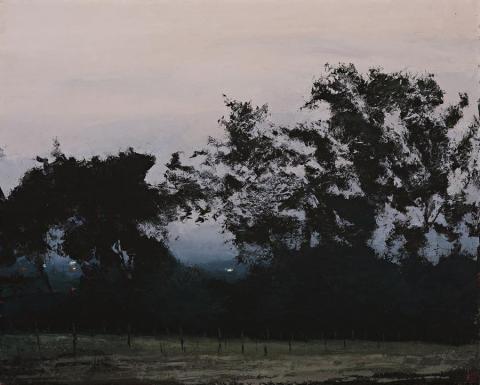BEYOND THE GARDEN, 2008
PHILIP WOLFHAGEN
oil and beeswax on linen
144.0 x 180.0 cm
signed, dated and inscribed verso: PHILIP WOLFHAGEN / “Beyond the Garden” 2008 ...
Philip Bacon Galleries, Brisbane
(label attached verso)
Private collection, Sydney
Philip Wolfhagen: Out of the Garden, Philip Bacon Galleries, Brisbane, 26 May – 20 June 2009
The impetus behind Philip Wolfhagen's alluring landscapes stems from his home in Tasmania. The surrounding terrain and the deep rooted connection to his birthplace – Wolfhagen's ancestors settled in northern Tasmania over 150 years ago – has shaped and influenced his artistic practice. Wolfhagen moved to Sydney from 1990 to 1995, and despite the allure of the 'big city' he would constantly yearn for Tasmania and would recreate visions of his home in an attempt to bridge the physical distance.
Wolfhagen's landscapes are sensory journeys that balance the line between reality and the imagined; that is, the observation of the surrounding topography and the quixotic landscape of his imagination. Composed within his studio, working from photographs and his memory as opposed to painting en plein air, each work is instilled with a sentimental indulgence as Wolfhagen conjures images which transcend the idea of a specific place.1 As demonstrated in Beyond the Garden, 2008, there is an aspect of ambiguous nostalgia as the viewer struggles to remember where they have witnessed this scene before. Attempting to recall that memory, one can feel the change in the air, the smell of the grass and the sound of the trees rustling in the wind. All of our senses are aroused and intensified through the visual indulgence that is present in Wolfhagen's sublime works.
Wolfhagen's paintings continue to inspire and captivate through the romantic portrayal of wispy clouds and enigmatic trees and the soft gradient of light and colour, which he can spend days concocting and perfecting as every shade is thoughtfully considered and prepared. We are also captivated by the personal and poignant depiction of the landscape and in the picture on offer, there is a subtle yet powerful impression of human interaction with the land through the fence that spans across the foreground. Traces of human occupation mark a more recent development in Wolfhagen's oeuvre, developing in the past decade or so as he continuously explores ways to expand his archetypal motifs.2
Working oil with beeswax to create lush and beguiling compositions, Wolfhagen is regarded as one of Australia's most significant landscape artists. He was awarded the Wynne Prize for landscape painting in 2007 and was a finalist in this year's competition. Wolfhagen is represented in the collections of The National Gallery of Australia, Canberra, Art Gallery of New South Wales, Sydney, National Gallery of Victoria, Melbourne, Art Gallery of South Australia, Adelaide and Tasmanian Museum and Art Gallery, Hobart.
1. Clark, J., 'Painting Memory' Illumination: The Art of Philip Wolfhagen, Newcastle Art Gallery, Newcastle, 2013, p. 22
2. Stewart, J., 'Philip Wolfhagen: Recall', Illumination: The Art of Philip Wolfhagen, Newcastle Art Gallery, Newcastle, 2013, p. 102
